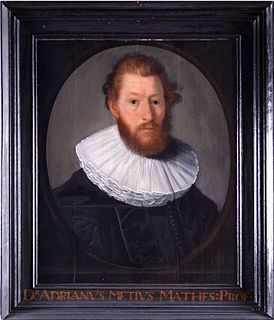Metis or Métis may refer to:

Fabricius is a lunar impact crater that is located within the northeast part of the walled plain Janssen. Attached to the north-northwest rim is the slightly larger crater Metius. Fabricius has multiple central peaks that rise to 0.8 km, with a rugged rise to the northwest running north–south. The rim is lumpy and somewhat distended, most noticeably to the southwest and south. It is 78 kilometers in diameter and 2,500 meters deep. It is from the Eratosthenian period, 3.2 to 1.1 billion years ago. It is named after David Fabricius, a 16th-century German astronomer.

Metius is a lunar impact crater located in the rugged highlands to the southeast of the Moon's near side. To the southwest the rim is attached to the crater Fabricius. Offset to the west-northwest is the heavily worn crater Brenner. Further away to the northeast is the crater Rheita and the long gorge Vallis Rheita.
JacobMetius was a Dutch instrument-maker and a specialist in grinding lenses. He is primarily known for the patent application he made for an optical telescope in October 1608, a few weeks after Hans Lippershey submitted a patent for the same device. He was the brother of the geometer and astronomer Adriaan Metius.

The Astronomer is a painting finished in about 1668 by the Dutch Golden Age painter Johannes Vermeer. It is in oil on canvas, 51 cm × 45 cm, and is on display at the Louvre, in Paris, France.
Metius is a genus of beetles in the family Carabidae, containing the following species:
Metius aeneus is a species of ground beetle in the subfamily Pterostichinae. It was described by Dejean in 1831.
Metius blandus is a species of ground beetle in the subfamily Pterostichinae. It was described by Dejean in 1828.
Metius carnifex is a species of ground beetle in the subfamily Pterostichinae. It was described by Dejean in 1828.
Metius flavipleuris is a species of ground beetle in the subfamily Pterostichinae. It was described by Straneo in 1951.
Metius obtusus is a species of ground beetle in the subfamily Pterostichinae. It was described by Straneo in 1951.
Metius titschacki is a species of ground beetle in the subfamily Pterostichinae. It was described by Straneo in 1951.
Metius latior is a species of ground beetle in the subfamily Pterostichinae. It was described by Putzeys in 1875.
Metius striatus is a species of ground beetle in the subfamily Pterostichinae. It was described by Putzeys in 1875.
Metius gigas is a species of ground beetle in the subfamily Pterostichinae. It was described by Straneo in 1953.
Metius kuscheli is a species of ground beetle in the subfamily Pterostichinae. It was described by Straneo in 1955.
Metius negrei is a species of ground beetle in the subfamily Pterostichinae. It was described by Straneo in 1977.
Metius (1571–1635) was a Dutch geometer and astronomer.

Adriaan Adriaanszoon, called Metius,, was a Dutch geometer and astronomer born in Alkmaar. The name "Metius" comes from the Dutch word meten ("measuring"), and therefore means something like "measurer" or "surveyor."

Adriaan Anthonisz (1527–1607) was a Dutch mathematician, surveyor, cartographer, and military engineer who specialized in the design of fortifications. As a mathematician Anthonisz discovered in 1585 the ratio of a circle's circumference to its diameter, which would later be called pi.




